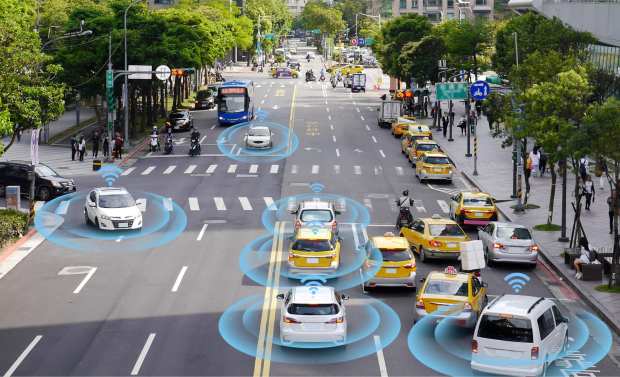Self-Driving Vehicles — And All Their Retail Benefits — Hit Speed Bumps

Connected and self-driving cars and truck stand as some of the next big frontiers when it comes to retail and retail innovation, but challenges to that future — real and potential problems that could slow down progress when it comes to autonomous vehicles — are increasing appearing on the horizon.
The latest example comes from The New York Times, which recently reported that jaywalking could jam up self-driving cars and trucks. “If pedestrians know they’ll never be run over, jaywalking could explode, grinding traffic to a halt,” its report stated. “One solution, suggested by an automotive industry official, is gates at each corner, which would periodically open to allow pedestrians to cross.”
Societal Issues
“With autonomous vehicles, the technical stuff will get worked out. It’s the societal part that’s the most challenging,” said Mark Rosekind, a head of the National Highway Traffic Safety Administration under President Barack Obama and now the chief safety innovation officer for Zoox, an autonomous vehicle developer, in a Times interview. According to that report, “the solution may be to program vehicles based on the local customs. In California, keeping up with the flow of freeway traffic typically means driving 10 to 15 miles an hour over the posted limit, whereas drivers in some parts of the East stay much closer to the legal speed (emphasis on some).”
Autonomous vehicles are lately running into serious roadblocks.
Sure, skepticism about the coming age of autonomous transportation was always out there. But as Uber, Google sibling Waymo, major automotive manufacturers and other companies poured money into the technology and announced fresh tests, a sense of optimism that the autonomous future was just around the corner continued to grow, with expectations occasionally approaching the level of hype.
Things are changing, at least according to new reports and some relatively fresh observations. The skepticism is rising — not about the coming of autonomous vehicles, but the timetable. And it seems plausible that 2019 will go down as a year during which the brakes were applied to the idea that mainstream acceptance of autonomous vehicles — which depends not only on the cost of the technology but on driving culture in general — will begin in the coming years instead of the coming decades.
Another New York Times report recently noted that “a year ago, Detroit and Silicon Valley had visions of putting thousands of self-driving taxis on the road in 2019, ushering in an age of driverless cars.” Now, however, “most of those cars have yet to arrive — and it will likely be years before they do. Several carmakers and technology companies have concluded that making autonomous vehicles is going to be harder, slower and costlier than they thought.”
New Timetable
Indeed, the report quoted Ford CEO Jim Hackett as saying, “We overestimated the arrival of autonomous vehicles.” That doesn’t mean Ford or other automotive and tech players are giving up on autonomous vehicles — but in many cases, they are reconsidering their efforts and even changing plans. For Ford, that means a fresh effort involving Volkswagen and autonomous vehicle technology from Argo AI. The immediate goal? According to the newspaper, to deploy such technology in service of “ridesharing services in a few urban zones as early as 2021,” which in turn could pave the way for driverless vehicles in the future.
As that and other recent reports have noted, the technology needed for that autonomous future — technology that goes well beyond the cars and trucks to include roads, maps and other parts of the larger ecosystem — is proving more complex than many in the industry had apparently anticipated. Think about all the unexpected hazards faced in your own drive — challenges that self-driving vehicles have to navigate around. Regulators will have to set new rules — and the pace of regulation is set by not only the pace of technological progress, but also political trends.
That’s a significant challenge for a significant area of real and potential commerce and payments. After all, every weekday morning, 135 million U.S. adults drive a car to work, with commutes ranging from as little as 15 minutes to over an hour, PYMNTS research shows. During this daily grind, motorists are driving $212 billion in commerce. That’s a huge opportunity for the emerging technology of automobiles — less time focused on driving means more time for shopping, to put it in the simplest terms. And the more connected a vehicle is — whether fully autonomous or not — that paves a smoother road for more commerce from consumers’ cars and trucks.
Keep your eyes on this particular road — work continues on autonomous vehicles but progress and the resulting retail benefits might be slower in coming than first expected.
